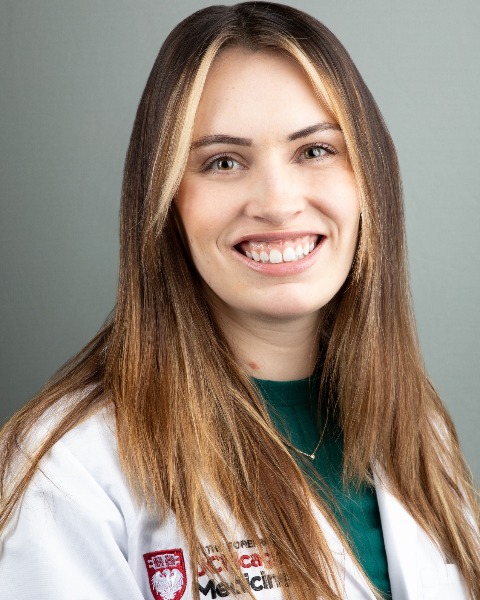Back


Clinical Posters
JL1026C: Pivoting During a Pandemic: Creation of an Oncology Procedure Team
Saturday, October 22, 2022
10:00 AM – 11:00 AM ET

Has Audio

Caroline Trotman, PA-C
Cellular Therapy Physician Assistant
University of Chicago Hospital
Poster Presenter(s)
BACKGROUND
Bone marrow biopsies and lumbar punctures (LPs) are vital procedures in diagnosing, monitoring, and treating hematologic malignancies. Prior to the onset of the COVID-19 pandemic in 2020, our tertiary academic center’s elective procedures were booked out months in advance and patients with urgent needs had to be overbooked, putting undue stress on the entire system. While the outpatient clinics had template availability, there were not enough providers to perform oncology procedures.
OBJECTIVE
We aimed to re-deploy inpatient advanced practice providers (APPs) to improve access to inpatient and outpatient procedures while maintaining consistent staffing of the inpatient APP services.
METHODS
During the first wave of the pandemic in early 2020, the inpatient APP Cellular Therapy Service (APP-CT) census was intentionally lowered due to concerns for safety with proceeding with stem cell transplants and cellular therapies. In May 2020, to better utilize the team’s staffing resources, the APP-CT service piloted an Oncology Procedure Team to perform bone marrow biopsies and LPs in the adult inpatient and outpatient settings. APPs on APP-CT volunteered as proceduralists for overstaffed shifts and a procedure schedule was created and emailed to outpatient support staff. A virtual Hematology-Oncology Procedure pager was carried 7 days/week, used for both inpatient and outpatient procedures. APPs credentialed on bone marrow biopsies and LPs trained new APPs to increase the number of trained proceduralists.
RESULTS
By shifting qualified inpatient APPs that would otherwise have been overstaffed, we were able to increase capacity and access for essential procedures. The monthly average of procedures pre-intervention was 87.4 with APP-CT performing 17% of procedures. The monthly average of procedures post-intervention was 105.8 with APP-CT performing 23% of procedures. Post-intervention, APP-CT revenue for bone marrow biopsies and LPs with intrathecal chemotherapy was $582,311 without the creation of any additional positions. Lastly, hematology/oncology fellows (HONC) that were in need of bone marrow biopsy training for their fellowship program were able to train with APPs.
CONCLUSIONS
The creation of the Oncology Procedure Team re-deployed staff during the COVID-19 crisis, increasing access to necessary oncology procedures, relieving stress from the outpatient teams, training HONC fellows, and utilizing staff in a creative and productive way that improved work satisfaction. We increased procedure availability and procedures performed, decreased the number of overbooked procedures added to busy outpatient providers’ schedules, thereby eliminating scheduling stresses for staff at multiple levels of the system. We also increased APP job satisfaction for providers who desired to do more procedures, and increased ability to train new APPs on these procedures.
IMPLICATIONS
We plan to continue to utilize inpatient APPs to expand the Oncology Procedure Team to cover outpatient procedure templates, with availability to assist with urgent inpatient procedures. Lastly, APP proceduralists are now being requested to train the new HONC fellows which demonstrates department-wide confidence in APP procedural skills.
Bone marrow biopsies and lumbar punctures (LPs) are vital procedures in diagnosing, monitoring, and treating hematologic malignancies. Prior to the onset of the COVID-19 pandemic in 2020, our tertiary academic center’s elective procedures were booked out months in advance and patients with urgent needs had to be overbooked, putting undue stress on the entire system. While the outpatient clinics had template availability, there were not enough providers to perform oncology procedures.
OBJECTIVE
We aimed to re-deploy inpatient advanced practice providers (APPs) to improve access to inpatient and outpatient procedures while maintaining consistent staffing of the inpatient APP services.
METHODS
During the first wave of the pandemic in early 2020, the inpatient APP Cellular Therapy Service (APP-CT) census was intentionally lowered due to concerns for safety with proceeding with stem cell transplants and cellular therapies. In May 2020, to better utilize the team’s staffing resources, the APP-CT service piloted an Oncology Procedure Team to perform bone marrow biopsies and LPs in the adult inpatient and outpatient settings. APPs on APP-CT volunteered as proceduralists for overstaffed shifts and a procedure schedule was created and emailed to outpatient support staff. A virtual Hematology-Oncology Procedure pager was carried 7 days/week, used for both inpatient and outpatient procedures. APPs credentialed on bone marrow biopsies and LPs trained new APPs to increase the number of trained proceduralists.
RESULTS
By shifting qualified inpatient APPs that would otherwise have been overstaffed, we were able to increase capacity and access for essential procedures. The monthly average of procedures pre-intervention was 87.4 with APP-CT performing 17% of procedures. The monthly average of procedures post-intervention was 105.8 with APP-CT performing 23% of procedures. Post-intervention, APP-CT revenue for bone marrow biopsies and LPs with intrathecal chemotherapy was $582,311 without the creation of any additional positions. Lastly, hematology/oncology fellows (HONC) that were in need of bone marrow biopsy training for their fellowship program were able to train with APPs.
CONCLUSIONS
The creation of the Oncology Procedure Team re-deployed staff during the COVID-19 crisis, increasing access to necessary oncology procedures, relieving stress from the outpatient teams, training HONC fellows, and utilizing staff in a creative and productive way that improved work satisfaction. We increased procedure availability and procedures performed, decreased the number of overbooked procedures added to busy outpatient providers’ schedules, thereby eliminating scheduling stresses for staff at multiple levels of the system. We also increased APP job satisfaction for providers who desired to do more procedures, and increased ability to train new APPs on these procedures.
IMPLICATIONS
We plan to continue to utilize inpatient APPs to expand the Oncology Procedure Team to cover outpatient procedure templates, with availability to assist with urgent inpatient procedures. Lastly, APP proceduralists are now being requested to train the new HONC fellows which demonstrates department-wide confidence in APP procedural skills.

